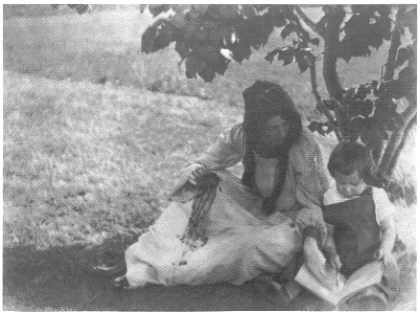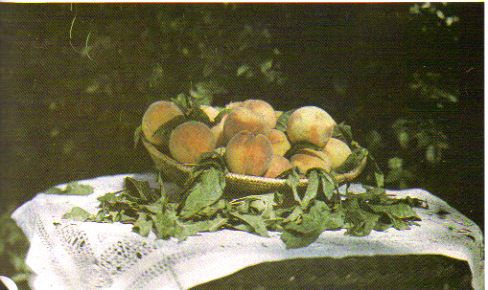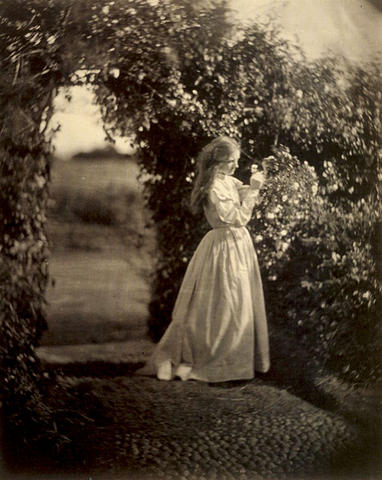Ellen and Jim Have a Blog, Too
We are two part-time academics. Ellen teaches in the English department and Jim in the IT program at George Mason University.


Women's faery poetry · 18 June 06
Dear Harriet,
First, a photograph, The Picture Book by Gertrude Kasebier (1903):

I spent today reading essays on English poetry written by women from the later 17th through the early 19th century poetry; yesterday I was reading poetry in the volumes of Fullard (British Women Poets 1660-1800, Lonsdale (Eighteenth Century Women Poets), and Toordi (Contemporary American Women Poets where contemporary means from around 1920 to 1937, the publication date of the collection).
I enjoyed myself intensely, and loved much of what I read; nevertheless, I came to the conclusion that the winnowing process, which slowly, through publication, serious attention by the finest minds writing in the language, and time and thoughtful analytical informed commentary, sorts out inferior from superior texts has not yet begun for poetry by women. Thus any anthology or discussion of any poetry by women immediately runs the risk of the writer or collector not able to distinguish good from bad.
Last week I wrote to you about Isobel Armstrong’s analysis of women’s poetry as characteristically fiercely laconic ("The Gush of the Feminine") and about Margaret Doody’s analysis of women’s poetry as one where the writer identifies physically and intimately with small animals ("Sensuousness in the Poetry of 18th Century Women Poets"). And about a month ago I wrote about retirement and friendship poems by women, Women’s Counter-universes, and their strong tendency to turn all genres into life-writing. For tonight I’d like to add another type and trope: faery writing and pictures. Doody explains the appeal for women:
"these (imaginary) beings offer a reflecting screen where sensation and reflection can be played with, away from the world of man-made regulations and cultural pressures … fairies … do not know death … they do not know pain; emotional suffering is not part of their scheme of life.
Fairies do not have to be moral—a great convenience, and an enviable one to women who are always being told they must be moral, chaste, and very careful, and should always put other people first."
Earlier women poets who practised this exquisitely well in whole poems or just passages inside longer poems (and thus even famously) include Margaret Lucas Cavendish, Duchess of Newcastle (Queen Mab poetry), Anne Finch (so many out of which I’ll name "Nocturnal Reverie"), Frances Greville ("A Prayer for Indifference"), Anna Barbauld ("Verses Written in an Alcove," "A Summer’s Evening’s Meditation"), Mary Whateley Darwell ("The Pleasures of Contemplation"), Anna Seward ("Song of the Faeries to the Sea-Nymphs"), Ann Radcliffe, Emily Bronte (Gondal poems), Christina Rossetti ("Goblin Market"). More recent: Sara Teasdale, Elinor Wylie, H.D., Sylvia Townsend Warner.
Sensuous pleasure and escape, often at twilight, by the sea, a refuge for the fanciful. I can’t resist sending along a little-known favorite poem by Radcliffe (attributed to her Emily in The Mysteries of Udolpho), where she is a powerful elusive mermaid:
The Sea-Nymph
Down, down a thousand fathom deep,
Among the sounding seas I go;
Play round the foot of every steep
Whose cliffs above the ocean grow.
There, within their secret caves,
I hear the mighty rivers roar;
And guide their streams through Neptune’s waves
To bless the green earth’s inmost shore:
And bid the freshen’d waters glide,
For fern-crown’d nymphs of lake, or brook,
Through winding woods and pastures wide,
And many a wild, romantic nook.
For this the nymphs, at fall of eve,
Oft dance upon the flow’ry banks,
And sing my name, and garlands weave
To bear beneath the wave their thanks.
In coral bow’rs I love to lie,
And hear the surges roll above,
And, through the waters, view on high
The proud ships sail, and gay clouds move.
And oft at midnight’s stillest hour,
When summer seas the vessel lave,
I love to prove my charmful pow’r
While floating on the moon-light wave.
And when deep sleep the crew has bound,
And the sad lover musing leans
O’er the ship’s side, I breathe around
Such strains as speak no mortal means!
O’er the dim waves his searching eye
Sees but the vessel’s lengthen’d shade;
Above—-the moon and azure sky;
Entranc’d he hears, and half afraid!
Sometimes a single note I swell,
That, softly sweet, at distance dies;
Then wake the magic of my shell,
And choral voices round me rise!
The trembling youth, charm’d by my strain,
Calls up the crew, who, silent, bend
O’er the high deck, but list in vain;
My song is hush’d, my wonders end!
Within the mountain’s woody bay,
Where the tall bark at anchor rides,
At twilight hour, with tritons gay,
I dance upon the lapsing tides.
And with my sister-nymphs I sport,
‘Till the broad sun looks o’er the floods;
Then, swift we seek our crystal court,
Deep in the wave, ‘mid Neptune’s woods.
In cool arcades and glassy halls
We pass the sultry hours of noon,
Beyond wherever sun-beam falls,
Weaving sea-flowers in gay festoon.
The while we chant our ditties sweet
To some soft shell that warbles near;
Join’d by the murmuring currents, fleet,
That glide along our halls so clear.
There, the pale pearl and sapphire blue,
And ruby red, and em’rald green,
Dart from the domes a changing hue,
And sparry columns deck the scene.
When the dark storm scowls o’er the deep,
And long, long peals of thunder sound,
On some high cliff my watch I keep
O’er all the restless seas around:
‘Till on the ridgy wave, afar,
Comes the lone vessel, labouring slow,
Spreading the white foam in the air,
With sail and topmast bending low.
Then, plunge I ‘mid the ocean’s roar,
My way by quiv’ring lightnings shewn,
To guide the bark to peaceful shore,
And hush the sailor’s fearful groan.
And if too late I reach its side
To save it from the ‘whelming surge,
I call my dolphins o’er the tide,
To bear the crew where isles emerge.
Their mournful spirits soon I cheer,
While round the desert coast I go,
With warbled songs they faintly hear,
Oft as the stormy gust sinks low.
My music leads to lofty groves,
That wild upon the sea-bank wave;
Where sweet fruits bloom, and fresh spring roves,
And closing boughs the tempest brave.
The spirits of the air obey
My potent voice they love so well;
And, on the clouds, paint visions gay,
While strains more sweet at distance swell.
And thus the lonely hours I cheat,
Soothing the ship-wreck’d sailor’s heart,
‘Till from the waves the storms retreat,
And o’er the east the day-beams dart.
Neptune for this oft binds me fast
To rocks below, with coral chain,
Till all the tempest’s over-past,
And drowning seamen cry in vain.
Whoe’er ye are that love my lay,
Come, when red sun-set tints the wave
To the still sands, where fairies play;
There, in cool seas, I love to lave.
This poem is matched by many of the set prose pieces in Udolpho where Emily gazes out at fantastical pageants in Venice, e.g.,
Neptune, with Venice personified as his queen, came on the undulating waves, surrounded by tritons and sea-nymphs. The fantastic splendour of this spectacle, together with the grandeur of the surrounding palaces, appeared like the vision of a poet suddenly embodied, and the fanciful images, which it awakened in Emily’s mind, lingered there … She indulged herself in imagining what might be the manners and delights of a sea-nymph, till she almost wished to throw off the habits of mortality, and plunge into the green waves to participate them.
Three analogues in pictures. For sensuousness as tactile experience, physical beauty and delicious taste, all wrapped up in a pastoral gardening frame, this Still Life by Laurie Gilpin (1981):

Dressing up, again tactile experiences, smells, exquisite beauty, again pastoral, as in Julia Margaret Cameron’s safe fantasies, The Gardener’s Daughter, (1873):

And enacting the dream, the moral holiday, The Picture Book (see directly above too), pleasurable relations, reading with another in an idyllic landscape, with which I began.
Since the high medieval and again Renaissance through early 17th century (Shakespeare, Drayton, Herrick) in Europe when you find men writing in the faery way, hardly any men have written this way in verse. I can think of Dryden’s beautiful imitation of the medieval The Flower and the Leaf, which he thought by a woman. Painters of the later 19th century do use faery pictures for escape (J. W. Waterhouse and Edward Burne-Jones, Richard Doyle’s fairy paintings) as do the water-colorists (who number women among them, e.g., Anna Alma-Tadema). Maybe when modern women read Tolkien, they read him the way women use faery writing. I know some of the illustrations in Caroline’s set of beautiful books for The Lord of the Rings, the illustrations are pure faery.
Still, most of the time when men write or picture this way, they do not write to escape, or find power or for sensuous delight. They seem rather to want to enter the world of romance (feminized) and assert their power over the genre or turn it into a quest or philosophical or overtly sexual experience (Blake).
Lately women have begun to use faery pictures this way too, though the intent is to subvert and to make sardonic comments, show cruelty, mix the faery with disquieting and alienating conjunctions. Examples may be found in Kara Walker and Laurie Simmons, whom, together with Samuel Palmer (another fantasist) I wrote about in a letter where I reprinted a strange retake on The Wizard of Oz. Simmons’s Coral Living Room is a gentler or more conservative or socially acceptable variant of faery & fantasy in a garden & now hangs in the Met; I’ve put a number of Simmons’s startling pictures in the photo albums at WWTTA.
I’ll write again a couple of evenings from now on a wonderful remarkable anthology of poetry by women published in 1937,
Adieu, my dear,
Sylvia
--
Posted by: Ellen
* * *
Comment
- I’ve gotten some positive responses offblog (approval praise as Mary K's "That is beautiful work, there; Ma'am"); Judy G offered specific commentary:
"I also like your blog about the faery poems and in particular the beautiful poem by Radcliffe.
The Cameron picture is lovely too. There are a lot of Julia Margaret Cameron photographs on the covers of Penguin editions of Hardy novels – some of them don’t seem very appropriate to the novel in question, but they are always striking pictures in their own right.
Judy"
— Elinor Jun 20, 10:51am # - I’m back from my trip now.
I learned how to use a typewriter at work. It was the first time I had used a typewriter. One thing that took a little bit of practice was how to line up the page so it types in the correct place. My fingers were a little shaky when typing at first, and I was wondering why it was harder to type on a typewriter if the keys are in the same place as on a computer. It’s probably just because it was new, something I’d never done before. Probably when people first learned how to use a computer after using typewriters their whole life, they wondered why it was harder to type on a computer even though the keys were in the same place. I figured out that the name of the caps lock key on a computer comes from the key on the typewriter locking the shift key. The caps lock key, and I think it just says lock, not caps lock, holds down the shift key. The other part that I kept forgetting was that I thought I should press the lock key to unlock it, but I really had to press the shift key to unlock it. One thing I think is cool about a typewriter is that you can press delete and then type the letter that you are trying to delete, and it erases it. I had fun learning how to use a typewriter.
— Jennica Jun 20, 11:29pm # - Dear Jennica,
When I first went to work when I was 16 I had to pass a typing test. I could type on a manual typewriter with snap keys, about 90 words a minute.
Typewriters are or were harder to operate than any computer keyboard. The typist really had to do all the work and it was physical work as well. And very poorly paid
Sylvia
— Sylvia Jun 22, 8:30am #
commenting closed for this article
